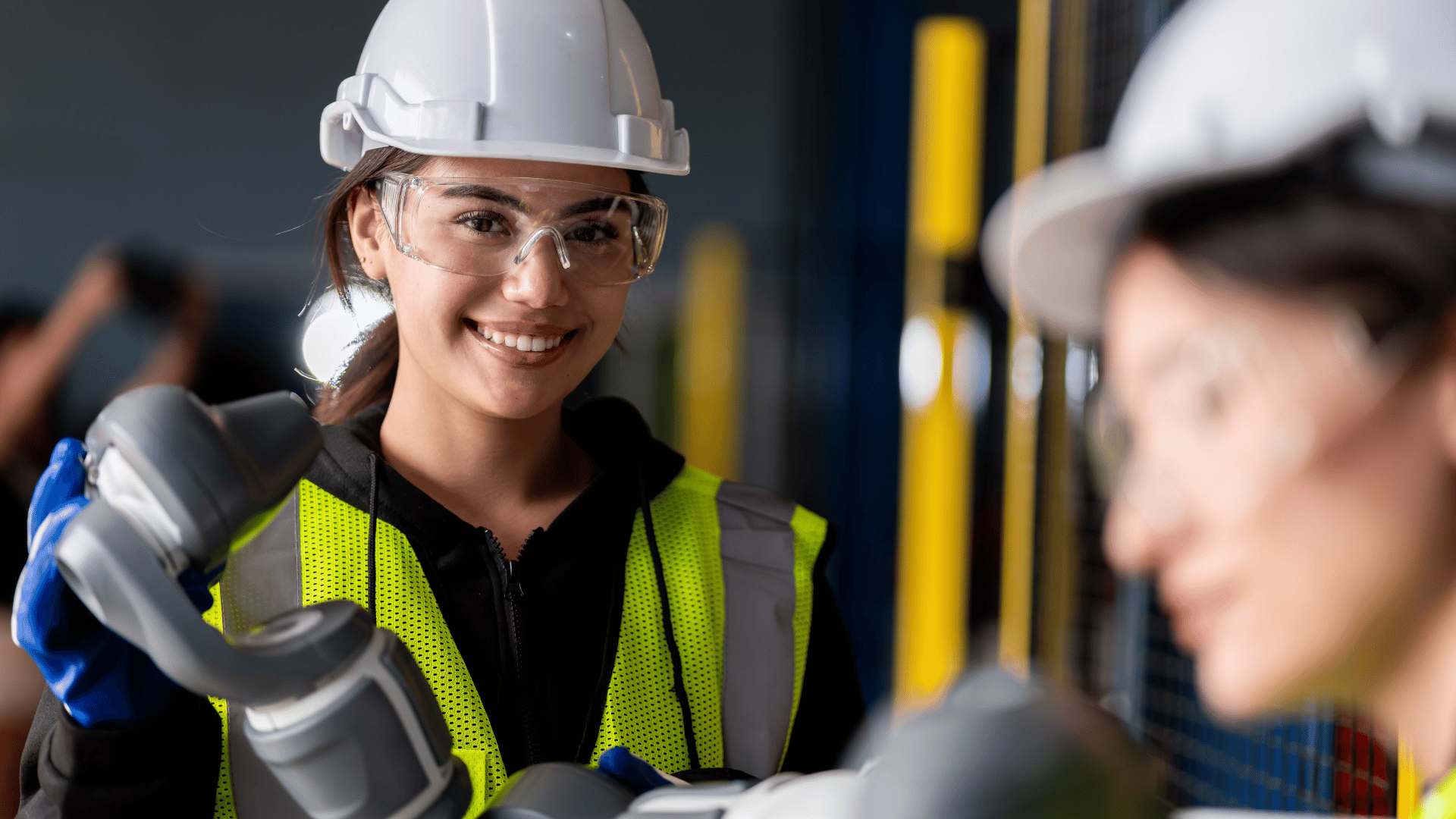Have you ever wondered how our world manages to spin so smoothly? From bustling factories to busy hospitals, from towering skyscrapers under construction to the machinery humming in their basements - it's a complex dance of safety and efficiency. But who or what choreographs this dance?
The unsung hero is CMMS, short for Computerized Maintenance Management Systems. It might sound technical (because it is), but stick with me here.
Picture an invisible safety net draped over industries, catching potential problems before they become disasters. That's CMMS in action! This system helps us ensure that machines are running right, assets are accounted for, and, above all else – people are safe.
Got your interest? Stay with us as we dive into how CMMS revolutionizes workplace safety in the manufacturing, healthcare, and construction industries. You're about to see firsthand its significant impact.
Understanding CMMS and Its Role in Safety Management

A Computerized Maintenance Management System (CMMS) is more than just maintenance management software. It's a safety net that catches potential problems before they become real ones, helping to create safer working environments across various industries.
Work order management, one of the core features of any CMMS solution, allows maintenance teams to streamline their tasks effectively. Instead of scribbling notes on paper or trying to remember everything mentally, work orders can be created electronically using mobile devices for easier tracking and follow-up.
The Magic Behind Preventive Maintenance Tasks
One might ask how maintenance activities such as preventive maintenance fit into this picture. Imagine your car warning you about an upcoming issue with its engine - pretty handy, right? That’s precisely what a well-implemented CMMS does. By scheduling regular check-ups on equipment, these systems help catch issues early when they're easiest—and cheapest—to fix.
This predictive approach saves money and helps ensure safe conditions by minimizing unexpected breakdowns that could pose hazards. Implementing CMMS software has been linked with significantly improved compliance regulations adherence thanks to its centralized database feature, which keeps track of all required inspections and tests.
Safety: A Top Priority
No matter the industry—manufacturing plants with heavy machinery or healthcare facilities housing sensitive medical apparatus—safety should always come first. This isn't just because accidents can cause harm but also because unsafe environments lead to inefficiencies and unnecessary costs over time. Research shows that most workplace accidents can be prevented with proper equipment maintenance, reinforcing the role of CMMS in creating safer work environments.
While safety tasks may seem like additional burdens for busy staff members, a good CMMS makes managing preventive maintenance and other important checks easy; by simplifying these processes, such systems help reduce stress on employees while enhancing overall maintenance operations.
| A Computerized Maintenance Management System (CMMS) isn't just management software; It's a business safety net. By digitizing work orders and scheduling regular equipment check-ups, CMMS helps catch potential problems early when they're cheapest to fix. Not only does this save money, but it also boosts safety by reducing unexpected breakdowns that could cause hazards. Regardless of your business size or industry type, leveraging a CMMS's power can significantly benefit your operational efficiency and workplace safety. |
The Importance of Safety in Various Industries

It's no secret that safety plays a crucial role across all industries. But why is it so important? Safe working conditions safeguard personnel and customers and increase productivity and morale. More importantly, adequate safety measures can help businesses comply with various regulations.
A tool like Computerized Maintenance Management Systems (CMMS) comes into play here by improving workplace safety standards.
Safety in the Manufacturing Industry
Heavy machinery poses safety issues in the manufacturing sector if improperly maintained or operated safely. Using CMMS for managing preventive maintenance tasks or creating work orders on a mobile device swiftly when a safety issue arises helps minimize these hazards significantly.
Safety in Healthcare Facilities
In healthcare facilities, ensuring patient and staff safety compliance is paramount. Properly managing medical equipment directly influences the quality of care provided. A CMMS solution plays a pivotal role by enabling teams to effectively manage parts inventory, ensuring timely repairs, and reducing potential risks in line with compliance requirements.
Safety on Construction Sites
Safety and adhering to regulatory compliance becomes even more critical on construction sites laden with potential dangers such as falling debris or faulty machinery. Here, too, CMMS proves beneficial through centralized database features that let maintenance teams track assets better, leading to safer working environments.
Remember this: while technology provides tools necessary for improved workplace security across industries, at its core, successful implementation hinges upon specially trained staff from everyone involved.
Safety and regulatory compliance aren't just about meeting industry requirements; it’s about caring enough to ensure our co-workers return home safely each day because they are family, too.
That's exactly what implementing software like CMMS does - it doesn't just ensure compliance but creates a safety culture where everyone feels protected and valued.
That's why the conversation inevitably leads us back to systems like CMMS that make such a big difference when discussing the importance of safety across various industries.
| Workplace safety isn't just a regulation - it's about caring for your team like family. With tools like Computerized Maintenance Management Systems (CMMS), industries from manufacturing to healthcare can better manage risks, promote productivity, and build a culture where everyone feels protected. Because true safety comes from a commitment by all involved. |
How CMMS Enhances Safety in the Manufacturing Industry

With its ability to automate and streamline preventative maintenance tasks, it significantly reduces risks associated with equipment failure.
The first line of defense against potential hazards often involves regular checks on machinery health. However, manually tracking numerous machines can be overwhelming for maintenance teams. Here's where CMMS plays an instrumental role - automating work orders and ensuring routine inspections don't fall through the cracks.
Maintaining Equipment Health
By implementing a CMMS solution, manufacturers can efficiently manage preventive maintenance schedules for their machinery fleet from one centralized database. This proactive approach helps avoid unexpected machine breakdowns, which could potentially lead to accidents or production halts.
Predictive maintenance features, enabled by sophisticated algorithms within many modern CMMS solutions, take this further – identifying potential issues before they become problems.
Safety Task Automation & Compliance Regulations
In addition to managing equipment health, another key aspect where CMMS aids in enhancing safety lies in compliance regulations adherence. Maintaining documentation is crucial but labor-intensive in pharmaceutical or chemical manufacturing industries governed by stringent safety norms.
A robust CMMS software system, however, simplifies these tasks. It allows for easy record-keeping, creating work orders, and ensuring adherence to safety regulations - all while accessible from any mobile device.
Optimized Parts Inventory
Finally, let's not forget the crucial role of tracking maintenance in managing parts inventory and maintaining a safe working environment. Running out of critical spare parts can cause machine downtime or rushed repairs – both risky scenarios. A CMMS helps keep an optimal stock level by automating reorder points based on tracking maintenance and usage trends, ensuring a safe working environment with a well-managed parts inventory, asset management, and safety schedules.
In conclusion, whether it's tracking maintenance, scheduling preventive maintenance tasks, or managing compliance records effectively, implementing CMMS software is undoubtedly an intelligent move toward making our manufacturing facilities safer places to work.
| A Computerized Maintenance Management System (CMMS) is transforming safety in the manufacturing industry by automating preventive maintenance tasks, reducing risks of equipment failure. It's not just about machine health - CMMS also simplifies compliance adherence and optimizes parts inventory management, making it a game-changer for safe operations. |
CMMS in Healthcare: Ensuring Patient and Staff Safety

The healthcare industry relies heavily on advanced equipment to diagnose, monitor, and treat patients. But if this vital gear fails? It can lead to catastrophic results - not just for patient health but also for staff safety.
This is where a Computerized Maintenance Management System (CMMS) steps in. A MicroMain CMMS solution, specifically designed for the healthcare sector, becomes essential for ensuring patient and staff safety by effectively managing preventive maintenance tasks of these critical devices.
Maintaining Equipment Health with CMMS
A core function of a healthcare-specific CMMS is overseeing work order management. Timely inspections and maintenance are crucial for life-saving machines like ventilators or MRI scanners.
By using mobile device applications connected to the centralized database of a CMMS system, technicians receive instant notifications about upcoming preventive maintenance tasks or any identified issues needing immediate attention. This quick response time helps prevent potential malfunctions that could endanger lives.
Safety Task Execution with Ease
Beyond equipment care alone, another aspect of maintaining safe hospital environments involves adhering strictly to compliance regulations. Here again, implementing CMMS software is instrumental because it provides teams with all necessary details regarding mandatory safety checks right at their fingertips via their mobile devices - from creating work orders to execution completion reports.
The EHS Daily Advisor points out how CMMS can streamline safety inspections, keeping environments secure for everyone involved.
Inventory Management: No More Out-of-Stock Situations
The healthcare sector often needs specific parts or components to repair equipment promptly. Imagine a scenario where an essential device breaks down, but the required spare part is not in stock - a nightmare no hospital wants to face.
A well-implemented CMMS helps manage preventive maintenance and the necessary parts inventory effectively. It keeps track of available spares, alerting management about low-stock situations ahead of time, thereby ensuring smooth operations without any unexpected hiccups.
When healthcare facilities adopt a robust CMMS system, they operate more efficiently. A strong CMMS system can guarantee the safety of both patients and personnel.
| Healthcare facilities lean on CMMS to safeguard both patients and staff. It's not just about equipment health; it ensures timely inspections, quick responses to issues, strict adherence to safety regulations, and effective inventory management. So, the vital gear stays in top shape, and spare parts are always available. A robust CMMS is key for smoother operations that put safety first. |
The Role of CMMS in Construction Safety

Computerized Maintenance Management Systems (CMMS) are a game changer for construction safety. They bring precision and reliability to managing work orders, tracking parts inventory, and carrying out safety plan-oriented preventive maintenance tasks.
As a project manager overseeing a busy construction site, I'm tasked with ensuring the safety of hundreds of equipment and personnel. You've got hundreds of pieces of equipment humming daily, not to mention your dedicated crew hustling about their tasks. Keeping everyone safe is your top priority, but it can be challenging with so many moving parts.
Managing Work Orders With Ease
A CMMS solution makes light work out of creating work orders. These systems allow quick creation and distribution from any mobile device, which means less downtime waiting for paperwork to shuffle around the job site. This keeps operations running smoothly while ensuring all necessary safety checks are completed before commencing work.
Maintaining Parts Inventory For Optimal Operation
In addition, an efficient parts inventory management software embedded within most CMMS ensures there's never a shortage or excess stockpile of essential components on-site. It also prevents potentially dangerous scenarios like using faulty or outdated machinery due to lack-of-parts emergencies.
Scheduling Preventive Maintenance Tasks To Avoid Accidents
Beyond that, these digital wizards help manage preventive maintenance schedules, too. That might sound trivial until you consider how critical regular maintenance is in preventing accidents caused by malfunctioning equipment. A robust CMMS can help ensure a safer working environment when implemented correctly.
Staying Compliant With Regulations For Enhanced Safety
Lastly, a CMMS makes it easier to adhere to compliance regulations. Construction is heavily regulated for safety, and failure to comply can result in hefty fines or, worse, endanger lives on site. The centralized database within the system helps maintenance teams track and document their efforts toward maintaining these standards.
In conclusion, implementing CMMS software into construction operations isn't just smart; it's essential for ensuring job site safety at every level.
| CMMS: The Safety Game Changer in Construction: CMMS makes managing work orders, tracking parts inventory, and scheduling preventive maintenance tasks easier. It keeps operations running smoothly with less downtime while ensuring safety checks are done before starting work. Plus, it helps stay compliant with regulations to enhance job site safety. |
Comparing the Impact of CMMS Across Industries

The power of a Computerized Maintenance Management System (CMMS) extends beyond just one industry. Its ability to streamline work orders, manage parts inventory, and schedule preventive maintenance tasks is universal.
Let's explore how different industries leverage this potent tool for safety management strategies.
Safety in Manufacturing with CMMS
In manufacturing, CMMS plays an integral role in creating safe working environments. Managing preventive maintenance schedules effectively through management software reduces unexpected equipment failures significantly. This reduces risks associated with machine malfunctions or breakdowns.
A well-implemented CMMS solution also helps maintain a centralized database of all assets, ensuring quick responses during emergencies.
Patient and Staff Safety in Healthcare via CMMS
Healthcare facilities heavily rely on complex machinery that needs constant monitoring and upkeep. A lapse can lead to dire consequences impacting patient health or staff safety. With the help of a mobile device integrated with a robust CMMS system, technicians can promptly attend to any faults detected before they escalate into critical issues.
Construction Safety Bolstered by CMMS
Safety precedes everything else in construction sites where heavy machinery operates continuously, as minor negligence could result in serious accidents. A soundly implemented CMMS system ensures equipment is in top-notch condition and safety standards are met, thus creating a safe working environment for all.
In essence, CMMS has a unique role to play across industries. While the tools used might be similar, their application can vary greatly depending on industry-specific requirements and compliance regulations.
The Future of Safety Management with CMMS
As we move into an increasingly digital world, the reliance on systems like CMMS will grow more robust. They will continue evolving to cater better to diverse industrial needs - shaping safer workplaces irrespective of their field.
| CMMS is the linchpin in ensuring safe environments across industries. By recording safety specifications, maintaining safety requirements, and providing easily accessible certification tracking, it empowers maintenance managers and specially trained staff to perform specific maintenance tasks with precision. The system's ability to create work orders, identify assets, and track completion dates ensures that company assets are maintained following safety specifications, ultimately promoting maintenance safety and peace of mind. |
Future Trends in Safety Management with CMMS
The landscape of safety management is evolving rapidly, and Computerized Maintenance Management Systems (CMMS) are at the forefront. Let's explore some exciting future trends that will make our working environments safer.
Artificial Intelligence (AI) Integration
We're seeing a trend towards integrating AI within CMMS solutions to enhance safety measures. These smart systems can predict potential issues by analyzing data from work orders and preventive maintenance tasks. By identifying patterns, AI could help prevent accidents caused by equipment failure or malfunctions.
Mobility Enhancements
Many businesses are now relying on mobile technology for their daily operations. Future advancements in CMMS software will offer more comprehensive mobile features, such as creating work orders or managing parts inventory remotely. This increases efficiency and lets teams respond quickly to any safety concerns arising onsite.
Incorporating IoT Technology
Internet of Things (IoT) technology is another significant player in the evolution of CMMS solutions. By connecting assets through an internet network, organizations can get real-time insights about their equipment’s health status from a centralized database - making it easier to manage preventive maintenance schedules while ensuring compliance regulations are met.
Focused Training Modules
A new wave of training modules leveraging virtual reality (VR) is being developed. With VR integrated into your CMMS solution, you can simulate high-risk scenarios, allowing maintenance teams firsthand experience in a safe environment. This can help prepare your team for unexpected situations and improve overall safety.
As we progress, these advancements will continue redefining the scope of CMMS applications in safety management. While each industry has unique needs and challenges, all can benefit from using technology like this to foster safer work environments.
| CMMS is shaping the future of safety management by integrating AI for predictive maintenance, enhancing mobility features for on-the-go operations, and leveraging IoT technology for real-time equipment health updates. Additionally, immersive VR training modules are being developed to prepare teams better. These advancements make work environments safer across all industries. |
Conclusion
So, you've been on a journey with us, exploring how CMMS is the unsung hero of safety. You've seen its impact in the manufacturing, healthcare, and construction industries.
Meeting safety requirements, providing safety training, scheduling workers, and ensuring that we meet compliance regulations are paramount in these industries. CMMS is the invisible safety net that catches potential issues before they become disasters.
You've witnessed how this technology plays out across different sectors, ensuring we manage preventive maintenance tasks effectively. The key takeaway? It’s an essential tool in today's world for maintaining efficiency while keeping everyone safe at work.
And remember, as we move forward into tomorrow, advancements in CMMS will only strengthen our commitment to workplace safety even more!
 For immediate assistance, please call us at (512) 328-3235
For immediate assistance, please call us at (512) 328-3235



